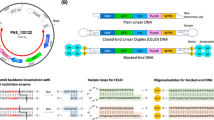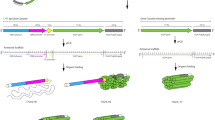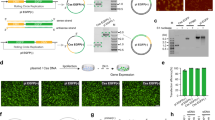Abstract
DNA can be internalized by mammalian cells without taking advantage of helper reagents. Here, we ask whether the spontaneous cellular uptake of double-stranded DNA (dsDNA) occurs in a biologically significant and sequence-dependent way. We describe a combinatorial approach to search for dsDNA sequence segments that are preferentially internalized. A selected dsDNA species was identified and covalently linked to a luciferase expression cassette. The increased apparent cellular uptake of long-chain recombinant DNA accompanied by an increased apparent expression of luciferase provides strong evidence for the view that (i) naked long-chain dsDNA can be taken up spontaneously by mammalian cells, (ii) specific sequences substantially increase this process, and (iii) dsDNA is transported into the nucleus of cells in a bioactive form. Experimental evidence indicates a tissue- or cell-type specificity for this process. This work indicates that, in principle, specific nucleotide sequences can facilitate the introduction of naked dsDNA into target cells of interest, thereby improving existing vector systems and providing a new methodology to study DNA uptake by mammalian cells. The cellular uptake of biologically active genetic material in vivo occurs to be conceivable.
This is a preview of subscription content, access via your institution
Access options
Subscribe to this journal
Receive 12 print issues and online access
$259.00 per year
only $21.58 per issue
Buy this article
- Purchase on Springer Link
- Instant access to full article PDF
Prices may be subject to local taxes which are calculated during checkout



Similar content being viewed by others
References
García-Olmo D, García-Olmo DC, Ontanón J, Martinez E . Horizontal transfer of DNA and the ‘genometastasis hypothesis’. Blood 2000; 95: 724–725.
Doerfler W et al. Foreign DNA integration – perturbations of the genome – oncogenesis. Ann NY Acad Sci 2001; 945: 276–288.
Ng EK et al. Presence of filterable and nonfilterable mRNA in the plasma of cancer patients and healthy individuals. Clin Chem 2002; 48: 1212–1217.
Anker P, Stroun M . Progress in the knowledge of circulating nucleic acids: plasma RNA is particle-associated. Can it become a general detection marker for a cancer blood test? Clin Chem 2002; 48: 1210–1211.
Schubbert R, Lettmann C, Doerfler W . Ingested foreign (phage M13) DNA survives transiently in the gastrointestinal tract and enters the bloodstream of mice. Mol Gen Genet 1994; 242: 495–504.
Doerfler W . Uptake of foreign DNA by mammalian cells via the gastrointestinal tract in mice: methylation of foreign DNA – a cellular defense mechanism. Curr Top Microbiol Immunol 1995; 197: 209–224.
Schubbert R, Renz D, Schmitz B, Doerfler W . Foreign (M13) DNA ingested by mice reaches peripheral leukocytes, spleen, and liver via the intestinal wall mucosa and can be covalently linked to mouse DNA. Proc Natl Acad Sci USA 1997; 94: 961–966.
Laktionov PP et al. Characterisation of membrane oligonucleotide-binding proteins and oligonucleotide uptake in keratinocytes. Nucleic Acids Res 1999; 27: 2315–2324.
de Diesbach P et al. Identification, purification and partial characterisation of an oligonucleotide receptor in membranes of HepG2 cells. Nucleic Acids Res 2000; 28: 868–874.
MacPherson I, Stoker M . Polyoma transformation of hamster cell clones – an investigation of genetic factors affecting cell competence. Virology 1962; 16: 147–151.
Takahashi K et al. Spontaneous transformation and immortalization of human endothelial cells. In Vitro Cell Dev Biol Anim 1990; 26: 265–274.
Dirks WG, MacLeod RA, Drexler HG . ECV304 (endothelial) is really T24 (bladder carcinoma): cell line cross-contamination at source. In Vitro Cell Dev Biol 1999; 35: 558–559.
Krieg AM . CpG motifs in bacterial DNA and their immune effects. Annu Rev Immunol 2002; 20: 709–760.
Basner-Tschakarjan E, Mirmohammadsadegh A, Baer A, Hengge UR . Uptake and trafficking of DNA in keratinocytes: evidence for DNA-binding proteins. Gene Therapy 2004; 11: 765–774.
Alam J, Cook JL . Reporter genes: application to the study of mammalian gene transcription. Anal Biochem 1990; 188: 245–254.
Acknowledgements
We thank Jens Warnecke and Winfried Wünsche for critical comments on the manuscript.
Author information
Authors and Affiliations
Rights and permissions
About this article
Cite this article
Lehmann, M., Sczakiel, G. Spontaneous uptake of biologically active recombinant DNA by mammalian cells via a selected DNA segment. Gene Ther 12, 446–451 (2005). https://doi.org/10.1038/sj.gt.3302428
Received:
Accepted:
Published:
Issue Date:
DOI: https://doi.org/10.1038/sj.gt.3302428
Keywords
This article is cited by
-
Ultrasonic microbubble VEGF gene delivery improves angiogenesis of senescent endothelial progenitor cells
Scientific Reports (2021)
-
An evolving function of DNA-containing exosomes in chemotherapy-induced immune response
Cell Research (2017)
-
Stem cells: promises and realities in cancer research
Clinical and Translational Oncology (2006)
-
Phosphorothioate‐stimulated uptake of short interfering RNA by human cells
EMBO reports (2005)



